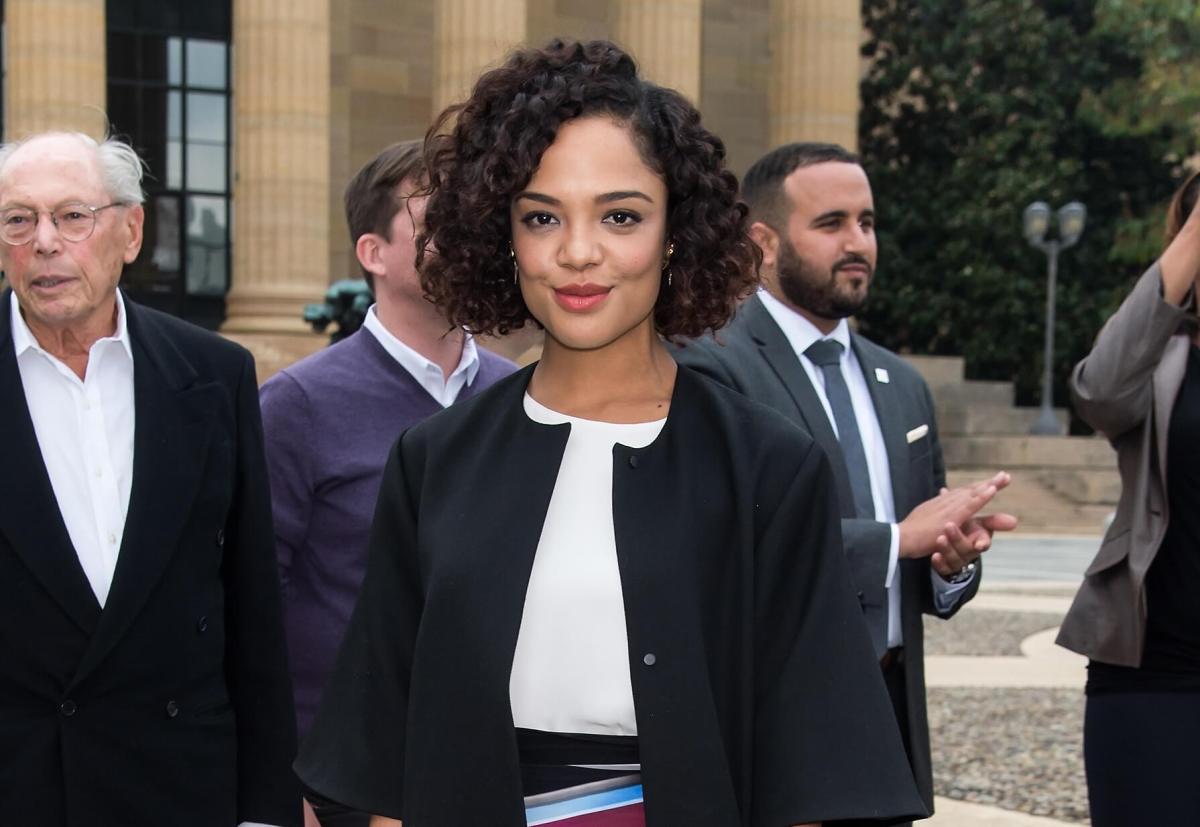Tessa Thompson doesn’t want to talk about who she’s wearing. That’s great, because I don’t want to ask. “I’m very conscious of it now, because when you do interviews — especially if you’re a woman — people talk about what you’re wearing,” the actress, promoting the “Rocky” spinoff “Creed,” says. But it’s not so clear-cut. “Truthfully, you’re given these garments that people spend a lot of time and energy making. They really want you to talk about them, because it’s their lifeline. So it’s odd. You’re like, ‘Don’t ask me about that, but,’” and then she namedrops a very famous designer I should know but don’t. Not talking about clothes means more time to talk about the work, and about “Creed,” in which she plays Bianca, a musician who falls for Michael B. Jordan’s aspiring boxer Adonis, the secret son of the deceased pugilist Apollo Creed. Bianca’s not just a typical love interest but someone with her own life and ambitions. And the actress — of “Veronica Mars,” “Selma” and “Dear White People,” in which she played serious-sarcastic activist Sam — was given a lot of agency, including cowriting the electronic music she plays. (Thompson also plays in the band Caught a Ghost.) RELATED: Interview: Michael B. Jordan still boxes after “Creed,” still gets scars You got to spend some time in Philadelphia before the shoot to learn about Bianca. How did the city help inform her?
She’s this patchwork of a lot of different areas and parts of Philadelphia. It meant I got to know the city in a very specific way. I was looking for points of reference. I was looking for somebody who felt like Bianca or would have been her friends. I went to a health food store and had this conversation with this guy. I assumed he wasn’t from Philly. But he said he was Philly-born and –raised. I asked, “Where in Philly?” He said, “North Philly.” I was surprised, because I had hung out in North Philly, and he seemed nothing like what I saw. He said he went to a Quaker school. I decided Bianca went to a Quaker school. She has this appetite for experimental music, and I think that’s where it came from. I think we’re becoming more and more open to the idea of being made of many influences, not just defined by one thing.
That’s very quickly becoming the norm, culturally. But it’s not necessarily being reflected in media. You don’t see many characters who feel like that seamless patchwork, that are coming from different points of view, that blur the lines of gender or race or what have you. It’s exciting to create characters like that. It’s so cool to have young people come up to me and say they relate to that, that they got to see parts of themselves on screen. That’s definitely what happens in “Dear White People.” Sam, your character, is allowed to be a black power activist who likes Ingmar Bergman and also Taylor Swift.
Totally. And it’s cool for me because I thrive on doing research. I went to school for cultural anthropology, and I dropped out to start acting. But I’m always interested in excavating why we do the things we do, and why we are what we are. It’s fun to play characters who draw from different things. With “Dear White People,” it meant I was listening to Taylor Swift. I can generalize and be so dismissive of pop culture and pop music. But listening to Taylor Swift I realized there’s a reason she’s very famous [laughs] and I understood what she was about. There are songs I got really into that I didn’t think I would have previously. At the same time I was watching and listening to Angela Davis. I was reading radical feminist literature. I was also watching all these episodes of “Golden Girls,” because I was obsessed with bringing some of the dryness of Bea Arthur’s performance in that. It meant my reference points were all over the place. I did not catch the Bea Arthur, admittedly.
[Laughs] It’s there. You can see it.
RELATED: Review: “Creed” shows how to do “Rocky” and fan fiction right This is the biggest movie you’ve done so far, but I also get the impression it was very handmade and close-knit.
It was super close-knit. When you think of big studio movies you think of 15 people in suits and lots of people coming in. It wasn’t like that. If you were in a scene, this was Ryan Coogler. [She gets up and crouches behind the hotel sofa] He’s here, with his tiny monitor. He was never where all the madness is and all the suits. He’s right here, next to you, and you’ll finish a take and he’ll pop up and be like, “Hey, so, when you said that word it didn’t feel like you liked it that much. How would you say it?” He was making the next Ryan Coogler movie, not the next “Rocky” movie. At the same time you are, sort of, making the next “Rocky” movie, and in Philadelphia, where they’re huge.
I remember one of our first fight sequences. There were maybe 600 background people. And Sly is in the ring, just stretching. The audience immediately goes, “Rocky! Rocky!” And then suddenly 600 people stood up, chanting, “Rocky!” It was the first moment I was like, “Oh my gosh, we’re making this movie.” I had almost forgotten that, because I was just busy making the next Ryan Coogler movie called “Creed.” It’s basically impossible to escape Rocky when you’re in Philadelphia.
I know. I spent my first two weeks in a hotel before I got to my place. I was like, “I’m not going to think of it as a ‘Rocky’ movie. We’re trying to make something fresh, so let’s approach it with freshness. I’ve seen all those movies, I have a reference point for them. I know I can forget about them.” I moved into my apartment, and literally next door is a Philadelphia souvenir shop, and the whole storefront is Rocky. There are Rocky bobbleheads. Every day as I leave for work, I’m like, “Hey, Rocky!” It was inescapable. And when we’d walk down the street with Sly, I swear they thought it was a documentary. They were like, “Yo, Rocky! You forget about us?” It means so much. They’re so invested in these stories.
Tessa Thompson on what it’s like to make a ‘Rocky’ film in Philadelphia

Getty Images
Follow Matt Prigge on Twitter @mattprigge


















